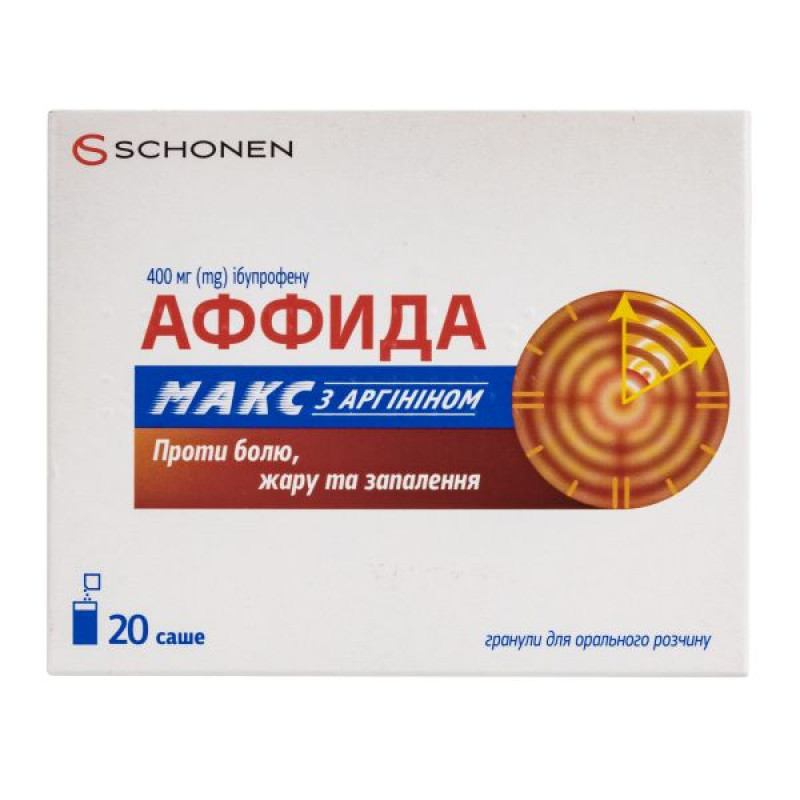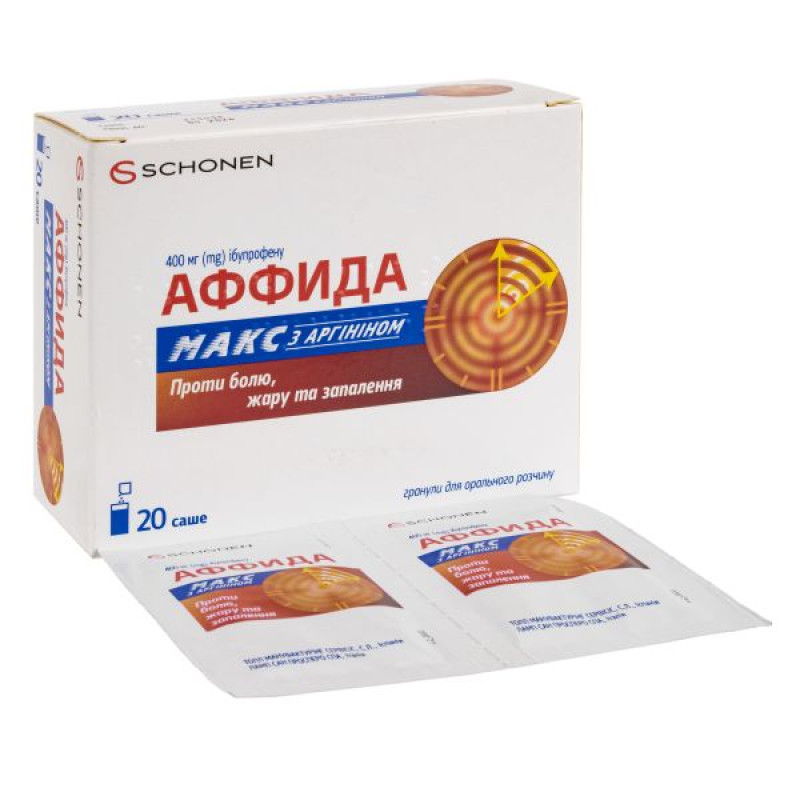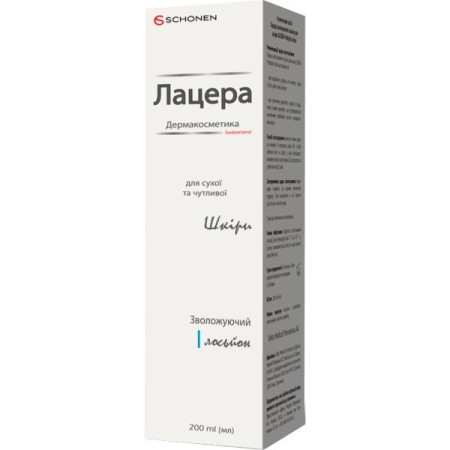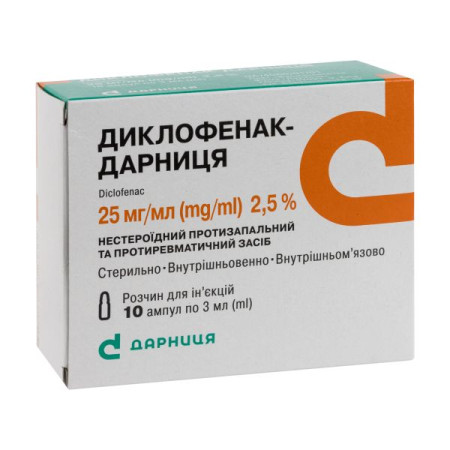Affida max with arginine sachet No. 20
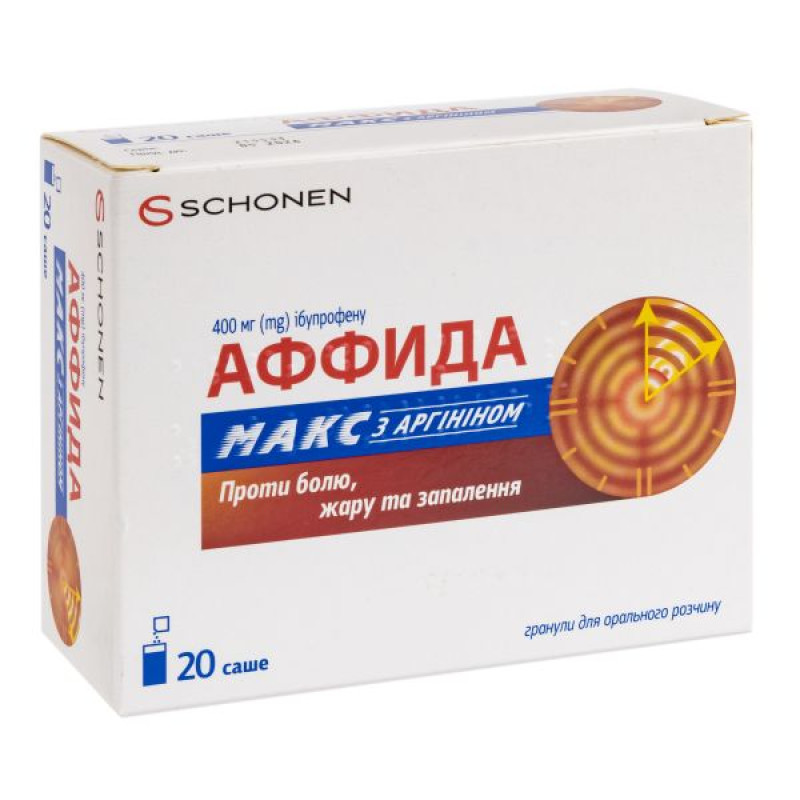
Instructions for Affida max with arginine sachet No. 20
Composition
active ingredient: ibuprofen;
1 sachet contains 400 mg* of ibuprofen;
excipients: arginine, aspartame (E 951), sugar, sodium bicarbonate, sodium saccharin, sodium lauryl sulfate, menthol, mint flavoring, purified water.
Dosage form
Granules for oral solution.
Main physicochemical properties: white or almost white granules with a mint aroma.
Pharmacotherapeutic group
Nonsteroidal anti-inflammatory and antirheumatic drugs.
ATX code M01A E01.
Pharmacological properties
Pharmacodynamics.
Ibuprofen is a nonsteroidal compound derived from propionic acid with pronounced anti-inflammatory, analgesic and antipyretic properties. Its mechanism of action may be due to inhibition of prostaglandin synthesis. Prostaglandins play an important role in the development of fever, pain and inflammation. Experimental data indicate that ibuprofen can competitively inhibit the effect of low doses of acetylsalicylic acid on platelet aggregation when administered simultaneously. Some pharmacodynamic studies have shown that when 400 mg of ibuprofen was taken within 8 hours before or within 30 minutes after a dose of immediate-release acetylsalicylic acid (81 mg), the effect of acetylsalicylic acid on thromboxane or platelet aggregation was reduced. However, the limited experimental data and uncertainty regarding the possibility of extrapolating them to the clinical situation do not allow a clear conclusion to be drawn about the possibility of regular use of ibuprofen and to predict the clinical effects of irregular use of ibuprofen.
Pharmacokinetics.
Ibuprofen is a drug that has linear pharmacokinetic properties.
Absorption
Ibuprofen is rapidly and approximately 80% absorbed from the gastrointestinal tract (GI) when taken orally. Ibuprofen with arginine in granules for oral solution has a high and rapid absorption due to the presence of the amino acid L-arginine, which promotes its solubilization and improves its bioavailability. Peak plasma concentrations are reached within 20 minutes after administration. No accumulation of the drug or its metabolites has been observed when ibuprofen with arginine in granules for oral solution is taken.
Spread
The apparent volume of distribution of ibuprofen after oral administration is 0.1 to 0.2 l/kg, and the significant binding to plasma proteins is about 99%.
Metabolism
Ibuprofen is extensively metabolized in the liver by hydroxylation and carboxylation of the isobutyl group, and ibuprofen metabolites have no pharmacological activity.
Breeding
Ibuprofen is excreted from the body mainly by the kidneys within 24 hours. Approximately 10% is excreted unchanged and 90% as inactive metabolites, mainly in the form of glucuronides.
Taking ibuprofen with food delays Tmax (from ± 2 hours on an empty stomach to ± 3 hours after eating), although this does not affect the extent of absorption.
Indication
Symptomatic treatment of fever.
Treatment of mild to moderate pain, including migraine.
Symptomatic treatment of arthritis (including juvenile rheumatoid arthritis), osteoarthritis, ankylosing spondylitis and non-rheumatic inflammation.
Symptomatic relief of primary dysmenorrhea.
Contraindication
Hypersensitivity to ibuprofen or to any of the excipients of the drug.
Hypersensitivity to salicylates or other NSAIDs (patients with a history of asthma, acute rhinitis, urticaria, angioedema or other allergic-type reactions after the use of substances with a similar effect).
Inflammatory bowel diseases.
Severe liver failure.
Severe renal failure.
Patients with hemorrhagic diathesis or other blood clotting disorders.
History of gastrointestinal bleeding or perforation associated with the use of NSAIDs.
Peptic ulcer/bleeding in active form or history of recurrence (two or more severe episodes of confirmed ulcer disease or bleeding).
Gastric or duodenal ulcer.
Severe heart failure (NYHA class IV).
3rd trimester of pregnancy (see section "Special instructions").
Cerebrovascular or other bleeding in the active phase.
Hematopoietic disorders of unknown etiology.
Severe dehydration (caused by vomiting, diarrhea, or insufficient fluid intake).
Interaction with other medicinal products and other types of interactions
NSAIDs should be used with caution in combination with other drugs that may increase the risk of gastrointestinal ulceration, gastrointestinal bleeding or renal dysfunction. Experimental data suggest that ibuprofen may inhibit the effect of low-dose acetylsalicylic acid on platelet aggregation when used concomitantly. However, due to the limitations of these data and the uncertainty about their extrapolation to the clinical situation, no clear conclusion can be drawn regarding regular use of ibuprofen and the likely clinical effects of irregular ibuprofen use.
Anticoagulants: NSAIDs may enhance the effects of dicoumarin anticoagulants, such as warfarin (see section "Special warnings and precautions for use").
Antiplatelet agents: NSAIDs increase the risk of gastrointestinal bleeding (see section "Special warnings and precautions for use").
Acetylsalicylic acid. It is generally not recommended to use ibuprofen simultaneously with acetylsalicylic acid due to the potential increase in adverse reactions, except in cases where acetylsalicylic acid (dose not exceeding 75 mg per day) has been prescribed by a doctor.
Experimental data suggest that ibuprofen may competitively inhibit the effect of low-dose acetylsalicylic acid on platelet aggregation when used concomitantly. Although there is uncertainty about the extrapolation of these data to the clinical situation, it cannot be excluded that regular long-term use of ibuprofen may reduce the cardioprotective effect of low-dose acetylsalicylic acid. With non-systematic use of ibuprofen, such a clinically significant effect is considered unlikely (see section "Pharmacodynamics").
Corticosteroids: Increased risk of gastrointestinal ulcers or bleeding when used with NSAIDs (see section "Special warnings and precautions for use").
Selective serotonin reuptake inhibitors: May increase the risk of gastrointestinal bleeding (see section "Special warnings and precautions for use").
Other NSAIDs, including selective cyclooxygenase-2 inhibitors. Concomitant administration with other NSAIDs should be avoided, as the use of different NSAIDs may increase the risk of gastrointestinal ulcers or bleeding due to a synergistic effect.
Methotrexate (at doses of 15 mg/week or more). When NSAIDs and methotrexate are used 24 hours apart, increased plasma levels of methotrexate are observed (the renal clearance of methotrexate may be reduced by the action of NSAIDs) with a subsequent increase in the risk of methotrexate toxicity. Therefore, ibuprofen should be avoided in patients receiving high-dose methotrexate treatment.
Hydantoins and sulfonamides. The toxic effects of these substances may be enhanced when used with NSAIDs. When used simultaneously with ibuprofen, the level of phenytoin in the blood plasma may increase.
Ticlopidine: NSAIDs should not be used in combination with ticlopidine due to the risk of additive effects on platelet function inhibition.
Lithium: NSAIDs may increase plasma lithium levels by reducing renal clearance of lithium. Concomitant use of lithium with NSAIDs should be avoided unless lithium levels are monitored. A reduction in the lithium dose should be considered.
Mifepristone: NSAIDs should not be used for 8–12 days after mifepristone administration, as this may reduce the effectiveness of mifepristone.
Caution should be exercised when used concomitantly with:
Digoxin: NSAIDs may increase the risk of digoxin toxicity by increasing its plasma levels.
Cardiac glycosides: NSAIDs may exacerbate heart failure by reducing glomerular filtration rate and increasing cardiac glycoside levels.
Methotrexate (low doses, less than 15 mg/week). The use of ibuprofen within 24 hours before or after methotrexate administration may lead to increased methotrexate concentrations and increased toxicity. When NSAIDs are used in combination with low-dose methotrexate, the patient's blood counts should be closely monitored, especially during the first weeks of concomitant use. In addition, renal impairment, regardless of degree, should be monitored particularly carefully, especially in elderly patients, and renal function should be monitored to prevent a possible decrease in methotrexate clearance.
Moclobemide. Increases the effect of ibuprofen.
Aminoglycosides: NSAIDs may reduce the excretion of aminoglycosides.
Pentoxifylline: Patients receiving ibuprofen in combination with pentoxifylline may have an increased risk of bleeding, therefore it is recommended to monitor bleeding time.
Phenytoin: Plasma levels of phenytoin may increase when co-administered with ibuprofen.
Probenecid and sulfipyrazone: Concomitant use may result in increased plasma concentrations of ibuprofen. This interaction may be due to a mechanism of inhibition at the site of renal tubular secretion and glucuronidation and may require adjustment of the ibuprofen dose.
Quinolones: There have been reports of convulsions that may be associated with the concomitant use of quinolones and some NSAIDs.
Thiazides, thiazide-related substances, loop diuretics and potassium-sparing diuretics. NSAIDs may reduce the diuretic effect of these drugs, and concomitant use of NSAIDs and diuretics may increase the risk of renal failure as a result of reduced renal blood flow. As with other NSAIDs, concomitant use with potassium-sparing diuretics may lead to increases in potassium levels, so plasma potassium levels should be monitored.
Cyclosporine, tacrolimus. Concomitant use with NSAIDs may increase the risk of nephrotoxicity due to decreased renal prostaglandin synthesis. Renal function should be closely monitored during concomitant use of these drugs.
Antihypertensive drugs (including ACE inhibitors or beta-blockers) and diuretics. NSAIDs may reduce the efficacy of diuretics and antihypertensive drugs. In some patients with impaired renal function (e.g. dehydrated patients or elderly patients with compromised renal function), the concomitant use of an ACE inhibitor or angiotensin II antagonist and drugs that inhibit cyclooxygenase may lead to further deterioration of renal function, including possible acute renal failure, which is usually reversible. Therefore, such combinations should be administered with caution, especially in the elderly. If long-term treatment is necessary, the patient should be adequately hydrated and consideration should be given to monitoring renal function at the beginning of the combination treatment and periodically thereafter. Diuretics may increase the risk of nephrotoxicity of NSAIDs.
Potassium-sparing diuretics: Concomitant use of ibuprofen and potassium-sparing diuretics may lead to hyperkalemia (serum potassium monitoring is recommended).
CYP2C9 inhibitor. Taking ibuprofen with CYP2C9 inhibitors may increase the exposure of ibuprofen (a CYP2C9 substrate). In a study conducted with voriconazole and fluconazole (CYP2C9 inhibitors), an increase in exposure to S (+)-ibuprofen from 80 to 100% was observed. A reduction in the ibuprofen dose should be considered when potent CYP2C9 inhibitors are co-administered, especially when high doses of ibuprofen are used with both voriconazole and fluconazole.
Thrombolytics: May increase the risk of bleeding.
Zidovudine. Concomitant use may increase the risk of erythrocyte toxicity due to effects on reticulocytes. Severe anemia occurs within a week of starting NSAIDs. Blood counts should be monitored during concomitant therapy with NSAIDs, especially at the beginning of treatment. There is evidence of an increased risk of hemarthrosis and hematoma in HIV-infected patients with hemophilia when zidovudine and ibuprofen are used concomitantly.
Hypoglycemic drugs. Ibuprofen enhances the hypoglycemic effect of oral antidiabetic drugs and insulin. Dose adjustment may be necessary. As a precautionary measure, blood glucose monitoring is recommended when these drugs are used concomitantly.
Herbal extracts. Ginkgo biloba, when used concomitantly with NSAIDs, may increase the risk of bleeding.
Food: Taking ibuprofen with food delays the rate of absorption of ibuprofen (see Pharmacokinetics).
Alcohol: Ibuprofen should be avoided in patients who abuse alcohol (14–20 or more drinks per week) due to the increased risk of gastrointestinal side effects, including bleeding.
Application features
Adverse reactions can be minimized by using the lowest effective dose for the shortest period of time to control symptoms (see section "Method of administration and dosage").
Other NSAIDs: Concomitant use of ibuprofen with other NSAIDs, including selective cyclooxygenase-2 inhibitors, increases the risk of adverse reactions and should be avoided.
Systemic lupus erythematosus and mixed connective tissue diseases: Ibuprofen should be used with caution in patients with systemic lupus erythematosus and mixed connective tissue diseases due to an increased risk of aseptic meningitis.
Porphyrin metabolism: Caution should be exercised in patients with congenital disorders of porphyrin metabolism (e.g. acute intermittent porphyria).
Gastrointestinal risks: Gastrointestinal bleeding, ulceration, or perforation, which can be fatal, has been reported with all NSAIDs at any time during treatment, with or without warning symptoms, regardless of a history of serious gastrointestinal bleeding.
The risk of gastrointestinal bleeding, ulceration or perforation increases with increasing doses of NSAIDs in patients with a history of ulcer, especially if the ulcer was complicated by bleeding or perforation (see section 4.3), and in elderly patients. Such patients should start treatment with the lowest possible dose. The possibility of concomitant administration of protective drugs (e.g. misoprostol or proton pump inhibitors) should be considered in those patients who are concomitantly taking low-dose acetylsalicylic acid or other drugs that may increase the risk from the gastrointestinal tract (see section 4.5).
Ibuprofen should be administered with caution to patients receiving concomitant treatment with drugs that may increase the risk of ulceration or bleeding, such as oral coumarin anticoagulants or antiplatelet agents such as acetylsalicylic acid (see section "Interaction with other medicinal products and other forms of interaction"). Caution should also be exercised when used concomitantly with oral corticosteroids and selective serotonin reuptake inhibitors. In the event of gastrointestinal bleeding or ulceration in patients receiving ibuprofen, treatment should be discontinued immediately (see section "Contraindications").
NSAIDs should be used with caution in patients with a history of ulcerative colitis and Crohn's disease, as exacerbation of these diseases is possible (see section "Adverse reactions").
Cardiovascular and cerebrovascular risks: Patients with a history of hypertension and/or heart failure should be treated with caution (consultation with a doctor is necessary), since, as with other NSAIDs, fluid retention, hypertension and edema have been reported with ibuprofen therapy.
Clinical trial data and epidemiological data suggest that the use of ibuprofen, especially at high doses (2400 mg/day), may be associated with a slightly increased risk of arterial thrombotic events (e.g. myocardial infarction or stroke). Overall, epidemiological studies do not suggest that low-dose ibuprofen (e.g. ≤ 1200 mg/day) may lead to an increased risk of arterial thrombotic events.
Patients with uncontrolled hypertension, congestive heart failure (NYHA class II-III), established ischemic heart disease, peripheral arterial disease and/or cerebrovascular disease should be prescribed ibuprofen only after careful clinical assessment. High doses (2400 mg per day) should be avoided.
The clinical picture should also be carefully assessed before starting long-term treatment in patients with risk factors for cardiovascular complications (e.g., hypertension, hyperlipidemia, diabetes mellitus, smoking), especially if high doses of ibuprofen (2400 mg per day) are required.
Cases of Kounis syndrome have been reported in patients receiving ibuprofen. Kounis syndrome is defined as cardiovascular symptoms secondary to an allergic or hypersensitivity reaction, associated with narrowing of the coronary arteries and potentially leading to myocardial infarction.
Severe cutaneous adverse reactions (SCARs): Severe cutaneous adverse reactions (SCARs), including exfoliative dermatitis, erythema multiforme, Stevens-Johnson syndrome (SJS), toxic epidermal necrolysis (TEN), drug-induced eosinophilia with systemic symptoms (DRESS) and acute generalised exanthematous pustulosis (AGEP), which can be life-threatening or fatal, have been reported with ibuprofen (see section 4.8). The majority of these reactions occurred within the first month of treatment.
If signs and symptoms suggestive of these reactions occur, ibuprofen should be discontinued immediately and alternative treatment considered (if necessary).
In exceptional cases, chickenpox can cause severe skin and soft tissue infections. At this time, the effect of NSAIDs on the worsening of these infections cannot be excluded, therefore it is recommended to avoid the use of ibuprofen in case of chickenpox.
Allergy: Caution should be exercised in patients with known allergic reactions to other substances, as these patients are also at increased risk of developing hypersensitivity reactions when using ibuprofen.
Patients suffering from hay fever, nasal polyps, chronic obstructive airway diseases, or a history of allergic diseases are at increased risk of allergic reactions, which may manifest as asthma attacks (so-called analgesic asthma), angioedema, or urticaria.
As with other NSAIDs, allergic reactions, including anaphylactic/anaphylactoid reactions, may occur, even without prior exposure to the drug.
Surgery: Caution should be exercised immediately following major surgery.
Renal/Hepatic Effects: Ibuprofen should be used with caution in patients with renal or hepatic disease, especially during concomitant diuretic therapy, as prostaglandin inhibition may lead to fluid retention and further deterioration of renal function. In such patients, the lowest possible dose of ibuprofen should be used and renal function should be monitored regularly. With prolonged use of ibuprofen, liver function tests, renal function and haematological function/blood count should be monitored regularly.
Effects on female fertility: There is limited evidence that long-term use of cyclooxygenase/prostaglandin synthesis inhibitors (>2400 mg/day and >10 days of treatment) may impair female fertility by affecting ovulation. This is reversible upon discontinuation of treatment.
Other: Like other NSAIDs, ibuprofen may cause a small transient increase in certain liver function tests and a significant increase in AST and ALT levels. If a significant increase in these values occurs, treatment should be discontinued (see sections 4.2 and 4.3).
Ibuprofen, like other NSAIDs, may reversibly inhibit platelet aggregation and function and increase bleeding time. Caution is recommended when ibuprofen is used concomitantly with oral anticoagulants.
Adverse reactions can be minimized by using the lowest effective dose to control symptoms for the shortest period of time (see section “Dosage and Administration” and gastrointestinal, cardiovascular risks).
Elderly patients have a higher incidence of adverse reactions to NSAIDs, especially gastrointestinal bleeding and perforation, which can be fatal (see section 4.2).
As with other NSAIDs, taking ibuprofen may mask the symptoms of infection.
Masking of symptoms of underlying infections. Ibuprofen may mask the symptoms of an infectious disease, which may delay the initiation of appropriate treatment and thereby complicate the course of the disease. This has been observed in bacterial community-acquired pneumonia and bacterial complications of varicella. When the drug is used for fever or for the relief of pain in infections, monitoring for the infectious disease is recommended. In outpatient settings, the patient should consult a doctor if symptoms persist or worsen.
Excipients warnings: This medicinal product contains aspartame, a derivative of phenylalanine, which is dangerous for patients with phenylketonuria.
This medicinal product contains sucrose. Patients with rare hereditary problems of fructose intolerance, glucose-galactose malabsorption or sucrase-isomaltase insufficiency should not take this medicinal product.
If you have been told you have an intolerance to some sugars, consult your doctor before taking this medicinal product.
Use during pregnancy or breastfeeding
I and II trimesters of pregnancy
Inhibition of prostaglandin synthesis may adversely affect pregnancy and/or embryo-foetal development. Data from epidemiological studies indicate an increased risk of miscarriage and of cardiac malformations and gastroschisis after use of a prostaglandin synthesis inhibitor in early pregnancy. The absolute risk of cardiovascular malformations increased from less than 1% to approximately 1.5%. This risk is believed to increase with dose and duration of treatment. From the 20th week of pregnancy, ibuprofen may cause oligohydramnios due to fetal renal dysfunction. This may occur shortly after initiation of treatment and is usually reversible after discontinuation of treatment. In addition, there have been reports of narrowing of the ductus arteriosus following treatment in the second trimester of pregnancy, most of which resolved after discontinuation of treatment. Therefore, ibuprofen should not be used during the first and second trimesters of pregnancy unless clearly necessary. If ibuprofen is used by a woman attempting to conceive, or during the first and second trimesters of pregnancy, the dose should be kept as low and the duration of treatment as short as possible. Antenatal monitoring for oligohydramnios and narrowing of the ductus arteriosus should be considered after exposure to ibuprofen for several days, starting from the 20th week of gestation. The use of Affida Max with Arginine should be discontinued if oligohydramnios or narrowing of the ductus arteriosus is detected.
3rd trimester of pregnancy
During the third trimester of pregnancy, all prostaglandin synthesis inhibitors may pose risks:
Risks to the fetus:
cardiopulmonary toxicity (with premature narrowing/closure of the ductus arteriosus and pulmonary hypertension);
renal dysfunction (see above);
Risks for the mother at the end of pregnancy and for the newborn:
possible prolongation of bleeding time, anti-aggregation effect, which can occur even at very low doses;
suppression of uterine contractions, leading to delayed or prolonged labor.
Therefore, ibuprofen is contraindicated during the third trimester of pregnancy (see Contraindications section).
Fertility
The use of ibuprofen may impair female fertility and is not recommended in women attempting to conceive. In women who have problems conceiving or who are undergoing investigation for infertility, discontinuation of ibuprofen should be considered.
In limited studies, ibuprofen has been found in breast milk at very low concentrations, so it is unlikely that it would have any adverse effects on a breastfed infant. However, ibuprofen is not recommended for use in breastfeeding women due to the potential risk of inhibition of prostaglandin synthesis in the newborn.
Ability to influence reaction speed when driving vehicles or other mechanisms
Patients who experience dizziness, vertigo, drowsiness, visual disturbances or other central nervous system disturbances while taking ibuprofen should refrain from driving or operating machinery. No special precautions are necessary for single doses or short-term treatment.
Method of administration and doses
Adverse reactions can be reduced by using the lowest effective dose for the shortest period of time necessary to control symptoms (see section "Special warnings and precautions for use").
Adults
Dosage should be adjusted individually, depending on the severity of the disorder and the patient's condition.
The recommended daily dose is 1200 mg of ibuprofen, divided into several doses.
If continuous use is necessary, the lowest effective dose should be prescribed that provides adequate control of the symptoms of the disease.
In rheumatoid arthritis, higher doses may be necessary, but in any case the maximum daily dose should not exceed 2400 mg.
For primary dysmenorrhea, the recommended dose is 400 mg of ibuprofen for pain relief. The maximum single dose is 400 mg, and the maximum daily dose is 1200 mg.
In inflammatory processes, the recommended daily dose is 1200–1800 mg of ibuprofen, divided into several doses. The maintenance dose is usually 800–1200 mg. The maximum daily dose should not exceed 2400 mg.
In case of mild to moderate pain and fever symptoms, the recommended daily dose is 800–1600 mg, divided into several doses, depending on the intensity of the symptoms and the response to treatment.
Children
In the case of juvenile rheumatoid arthritis, ibuprofen can be used in a dose of up to 40 mg/kg of body weight per day, divided into several doses.
Elderly patients
No significant differences in pharmacokinetic profile are observed in elderly patients, therefore no adjustment of dose or frequency of administration is considered necessary. If NSAIDs are required, the lowest effective dose should be used, as there is an increased risk of adverse reactions in elderly patients, who are more likely to have decreased renal, hepatic and cardiovascular function, and are more likely to have drug interactions. In particular, it is recommended to use the lowest effective dose. Only when tolerability of the drug has been established, the dose may be increased to that recommended for adults.
Kidney failure
NSAIDs should be used with caution in patients with renal impairment. In patients with mild or moderate renal dysfunction, treatment should be initiated at the lowest possible dose. Contraindicated in patients with severe renal impairment (see section "Contraindications").
Liver failure
Although the pharmacokinetics of ibuprofen are not altered in patients with hepatic impairment, NSAIDs should be used with extreme caution in these patients.
Patients with mild or moderate hepatic impairment should be started on the lowest possible dose under close supervision. Contraindicated in patients with severe hepatic impairment (see section 4.3).
Method of application
For oral use.
Before use, the contents of one sachet should be poured into half a glass of water and stirred for 2 minutes.
Patients suffering from gastrointestinal diseases should take the medicine with milk and/or during meals.
Children.
The drug is not recommended for use in children under 12 years of age, as the dose of ibuprofen contained in the drug does not correspond to the recommended dose for this age category.
Overdose
Most reported cases of overdose have been asymptomatic. The risk of symptoms occurs with ibuprofen doses above 80–100 mg/kg.
Symptoms of overdose occur within 4 hours after administration. The most common symptoms of overdose are mild, including nausea, vomiting, abdominal pain, very rarely diarrhea, lethargy, drowsiness, headache, tinnitus, nystagmus, tinnitus and ataxia. Symptoms of moderate to severe severity, such as gastrointestinal bleeding, hypotension, hypothermia, metabolic acidosis, convulsions, renal dysfunction, coma, respiratory failure in adults and transient episodes of apnea (in children after high doses) have been reported rarely.
When using small amounts of the drug (less than 50 mg/kg of ibuprofen), drinking water is recommended to minimize gastrointestinal disorders. When using significant amounts, oral administration of activated charcoal is recommended. Gastric emptying by vomiting may be appropriate only within 60 minutes after taking the drug. Therefore, gastric lavage is recommended if the patient has taken a potentially toxic or life-threatening dose within 1 hour. The benefit of forced diuresis, hemodialysis, and hemoperfusion is questionable, since ibuprofen is highly bound to plasma proteins.
Side effects
Adverse reactions are mainly associated with the pharmacological action of ibuprofen on prostaglandin synthesis.
The most common adverse reactions are gastrointestinal. Peptic ulcers, gastrointestinal perforations or bleeding, sometimes fatal, may occur, especially in elderly patients (see section "Special warnings and precautions for use").
Nausea, vomiting, diarrhea, flatulence, constipation, dyspepsia, abdominal pain, melena, hematemesis, ulcerative stomatitis, exacerbation of colitis and Crohn's disease may occur with ibuprofen (see section "Special warnings and precautions for use"). Less frequently, gastritis has been reported. There have been reports of edema, hypertension, and heart failure associated with the use of NSAIDs.
Adverse reactions possibly related to ibuprofen are listed by system organ class and frequency as follows: very common (≥ 1/10), common (≥ 1/100 to < 1/10), uncommon (≥ 1/1,000 to < 1/100), rare (≥ 1/10,000 to < 1/1,000), very rare (< 1/10,000), frequency unknown (cannot be estimated from the available data).
| MedDRA System Organ Class | Frequency | ||||
| Often | Infrequently | Rarely | Very rare | Frequency unknown | |
| Infectious and parasitic diseases | Exacerbation of inflammatory infectious diseases (necrotizing fasciitis) | ||||
| From the side of the blood and lymphatic systems | Aplastic anemia | Anemia, leukopenia, thrombocytopenia, pancytopenia, agranulocytosis, prolonged bleeding time | |||
| On the part of the immune system | Allergic reactions, hypersensitivity reactions with skin rashes, itching and asthma attacks | Anaphylaxis | Severe hypersensitivity reactions with bronchospasm, dyspnea, tachycardia, hypotension, and shock | Anaphylactic shock | |
| Mental disorders | Insomnia, anxiety, restlessness | Psychotic reactions, nervousness, irritability, depression, confusion, disorientation | |||
| From the nervous system | Fatigue, drowsiness, headache, dizziness | Insomnia, agitation, irritability | Paresthesia | Aseptic meningitis | |
| From the organs of vision | Visual impairment | Reversible toxic amblyopia | Optic disc swelling | ||
| Hearing and balance disorders | Dizziness | Tinnitus | Hearing impairment | ||
| From the heart | Increased heart rate, heart failure | Acute cardiovascular failure, Kounis syndrome | |||
| From the vascular side | Arterial hypertension | Arterial thrombosis | |||
| Respiratory, thoracic and mediastinal disorders | Asthma, asthma exacerbation, bronchospasm, dyspnoea | Throat irritation | |||
| From the gastrointestinal tract | Heartburn, abdominal pain, nausea, vomiting, flatulence, diarrhea, constipation, minor bleeding | Gastrointestinal ulcers with possible bleeding and perforation, ulcerative stomatitis, exacerbation of
Specifications
Characteristics
Active ingredient
Ibuprofen
Adults
Can
Country of manufacture
Italy
Diabetics
With caution
Dosage
400 мг
Drivers
With caution
For allergies
With caution
For children
From the age of 12
Form
Powders and granules
Method of application
Inside, liquid
Nursing
It is impossible.
Pregnant
It is impossible.
Primary packaging
package
Producer
Delta Medical Promotions
Quantity per package
20 sachets
Trade name
Affidavit
Vacation conditions
Without a prescription
Reviews
There are no reviews for this product. There are no reviews for this product, be the first to leave your review.
Answers & questions
Add your question and we will answer as soon as possible.
No questions about this product, be the first and ask your question.
You are watched
| |||







